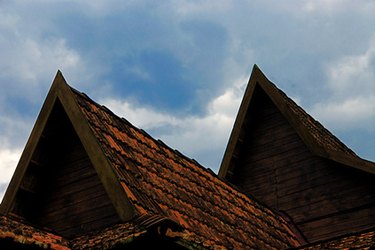Changing the complete look and style of your roof can be a big job but with great payoffs. A flat roof can often have pooling water that can lead to leaks. Also, the appearance of a flat roof may not be desirable for a residential home. Pitching a flat roof can let you add an attic or second floor with slanted ceilings. If you prefer the look of shingles over tar, a pitched roof may also be an option for you. Converting your flat roof to a pitched roof is a large project that often requires professionals and expensive tools.

Video of the Day
Things You'll Need
Roofing Nails
Bridging Material
Plywood
Pre-Manufactured Roof Trusses
Crowbar
Roofing Material
Measuring Tape
Flat Shover Or Ice Pick
Saws
Tar Paper
Step 1
Determine the span of the roof. Measure from one top plate to the other across the roof in the direction that is perpendicular to the direction which you wish to line the peak of your new roof. Top plates are the horizontal frames that run along the joists of the roof. Include the overhang of the faceboards. Faceboards are the boards nailed to the ends of any exposed roof overhangs. Add all the measurements of the width together and divide it in half. This number will tell you where the peak of your pitched roof will sit.
Video of the Day
Step 2
Determine the pitch of the roof. Consult with your roof trusses manual to find the pre-determined pitch of your roof. Modern roof packages determine this calculation for you.
Step 3
Remove all of the old roofing materials including any plywood covering under the roofing materials. Scrape the surface of the roof with a flat shovel, ice pick or similar tool. Use your hands to peel materials off the the surface of the roof. The wood frame of the roof needs to be completely exposed and clean.
Step 4
Tie the existing roof lumber to the new roof trusses. Consult the manual of your specific trusses for appropriate placement and attachments. The trusses will come with the necessary supplies to connect them to the old roof.
Step 5
Apply a new sheath to the new roof. If your old roof's sheath was in very good condition, you can use it on the new roof. Consult with your city or town's local building codes on the material that you can use. This includes plywood or OSB. Secure the material in place with galvanized roofing nails.
Step 6
Lay tar paper over the entire span of the roof. Trim off any excess that hangs over the ends.
Step 7
Install new roofing material. This can be any roof covering of your choice. Examples include shingles, slate or rubber.